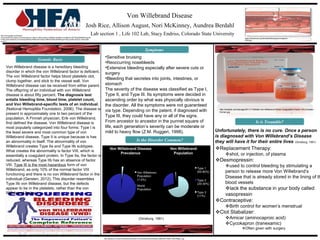Recommended
hematology.wustl.edu/conferences/presentations/bli... hematology.wustl.edu/...

hematology.wustl.edu/conferences/presentations/bli... hematology.wustl.edu/...MedicineAndHealthCancer
Recommended
hematology.wustl.edu/conferences/presentations/bli... hematology.wustl.edu/...

hematology.wustl.edu/conferences/presentations/bli... hematology.wustl.edu/...MedicineAndHealthCancer
More Related Content
Similar to Poster template
Similar to Poster template (20)
UV0024 This case is based on ideas and discussions.docx

UV0024 This case is based on ideas and discussions.docx
Acute Myeloid Leukemia (AML): Cancer of the Blood & Bone Marrow

Acute Myeloid Leukemia (AML): Cancer of the Blood & Bone Marrow
9212017 9222017 gmo online documention lethality review MANTICORE

9212017 9222017 gmo online documention lethality review MANTICORE
Poster template
- 1. Motor Unit EMG Motor Unit EMG Von Willebrand Disease Josh Rice, Allison August, Nori McKinney, Aundrea Berdahl Lab section 1 , Life 102 Lab, Stacy Endriss, Colorado State University Genetic Basis * * *Is is Treatable? Symptoms Is the Disorder Common? http://www.google.com/imgres? q=hemophilia+foundation+of+america&num=10&um=1&hl=en&biw=1280&bih=603&tbm=isch&tbnid=XfOTEjvjkDBkMM:&imgrefu rl=http://www.facebook.com/hemophiliafed%3Ffilter%3D1&docid=fBRC05JMiLMlOM&imgurl=http://profile.ak.fbcdn.net/hprofile- ak-prn1/ http://ecx.images-amazon.com/images/I/51FGrm3FtHL._SL500_AA300_.jpg http://whatafy.com/storage/2011/11/Wilate-Von-Willebrand-Factor-Coagulation-Factor-VIII-Complex- Human.jpg https://ufandshands.org/sites/default/files/graphics/images/en /9326.jpg http://sphotos-a.xx.fbcdn.net/hphotos-ash3/c22.0.403.403/p403x403/554309_428651587184807_929749686_n.jpg •Sensitive bruising •Reoccurring nosebleeds •Extensive bleeding especially after severe cuts or surgery •Bleeding that secretes into joints, intestines, or stomach The severity of the disease was classified as Type I, Type II, and Type III. Its symptoms were decided in ascending order by what was physically obvious is the disorder. All the symptoms were not guaranteed via type. Depending on the patent, if diagnosed with Type III, they could have any or all of the signs. From ancestor to ancestor in the punnet square of life, each generation’s severity can be moderate or mild to heavy flow (Z.M. Ruggeri, 1998). (Ginsburg, 1991) Unfortunately, there is no cure. Once a person is diagnosed with Von Willebrand’s Disease they will have it for their entire lives. (Ginsburg, 1991) Von Willebrand disease is a hereditary bleeding disorder in which the von Willebrand factor is deficient. The von Willebrand factor helps blood platelets clot, clump together, and stick to the vessel wall. Von Willebrand disease can be received from either parent. The offspring of an individual with von Willebrand disease is about fifty percent. The diagnosis test entails bleeding time, blood time, platelet count, and Von Willebrand-specific tests of an individual. (National Hemoplilia Foundation, 2006). The disease is present in approximately one to two percent of the population. A Finnish physician, Erik von Willebrand, first defined the disease. Von Willebrand disease is most popularly categorized into four forms: Type I is the least severe and most common type of von Willebrand disease. Type II is unique because is has an abnormality in itself. The abnormality of von Willebrand creates Type IIa and Type IIb subtypes. What creates the abnormality is factor VIII, which is essentially a coagulant protein. In Type IIa, the factor is reduced, whereas Type IIb has an absence of factor VIII. Type III is the most hazardous form of von Willebrand, as only 10% of the normal factor VIII functioning and there is no von Willebrand factor in the individual (Gersten, 2012). This disorder resembles Type IIb von Willebrand disease, but the defects appear to be in the platelets, rather than the von Willebrand factor
